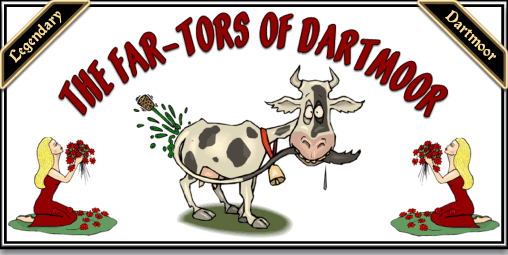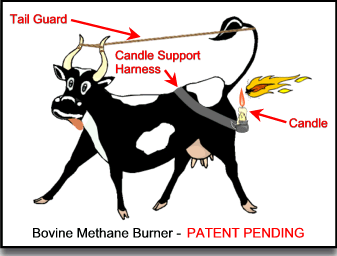
Next time you walk amongst the purple heathers of Dartmoor with the gentle breeze delicately wafting amongst the gorse you may even find that the aroma is even headier than ever. For this you can thank good old Tony Blair and his bunch of clowns for once again they have come up with another solution to combat climate change. Apparently one major source of pollution has or rather is the ‘Far Tors’ of Dartmoor or in other words the flatulent cattle which happily graze of the moorland slopes. Yes, as if the poor beleaguered Dartmoor farmer has not enough govern-mental headaches to contend with good old DEFRA have come up with a new one – stop your cows from farting and belching so much as their methane is melting the polar ice caps. So next time you are on the moor and are gazing at an idyllic landscape of tumbling streams and rocky tors over which herds of cattle contentedly graze just stop and think. Those filthy animals are belching and farting the world into oblivion by their disgusting methane emissions. May be it is some Orwellian plot from the animal world in which they exact their revenge on mankind by farting us into extinction – silent but deadly!
It has now been estimated that through belching and farting a single cow will produce about 500 litres of methane a day. When the total bovine headage in the UK is taken into consideration it is estimated that they emit roughly 7% of all Britain’s greenhouse gases. The experts suggest that methane gas is 23 times more efficient at global warming than carbon dioxide is and so it’s a priority to reduce the output.
Cattle nutritional experts consider that one way to reduce the bovine methane emissions is to change their diet. It seems that over the years our farmers have moved away from their natural type of foods in favour of more productive feed. Apparently the winter silage is too short which means the cattle are unable to chew it for long enough and so when it does reach the rumen its not as masticated as it should be and so produces more methane. One of the ideas is to make the silage cut longer which would enable the cattle to chew it for a greater amount of time. Other suggestions are to include microbes or inoculants in the feed to reduce methane production, one bright spark has even suggested that garlic could be one answer. Imagine what your cornflakes would taste like with garlic flavoured milk? So, at the moment DEFRA scientists are urging farmers to change what is being piled into their cows’ front ends. Rather ominously one DEFRA spokeswoman commented how:
“We do encourage farmers to look at this research and consider acting on it. There is no regulation (saying) they will have to change fodder, although that may be something we will have to look to in the future.”
The worrying part of that brief statement is, “that may be something we will have to look to in the future.” That means they have already got plans to exact some more money out of our farmers under the pretence that their cows are belching and farting too much. Now in some ways it is correct that there are some things some farmers can do to reduce the methane outputs. In some cases it would be easy to shove some garlic down a cows neck providing they are close to the farm. Unless someone comes up with a long lasting bolus, the only way that the moorland cattle can recieve regular doses of whatever is to round them up each time it’s ‘jollup’ time and when they are spread all over the moor this is no easy task.
In December 2006 DEFRA invested £750,000 into how cattle diets can be improved to allow for cuts in methane emissions. It was also announced this week that a:
“range of measures were being considered, including the agricultural emissions trading scheme.”
This would mean that methane emission limits would be set and any farmer who polluted above their agreed limit would then have to buy extra credits from what could be described as a ‘fart bank’. This bank would get ‘deposits’ from those farmers that were polluting under their agreed targets, a bit like the milk quota system. But again with that it didn’t take long for non-agricultural bodies to buy up the extra quota from farmers who weren’t producing to their maximum or had gone out of milking and then broker it on at a profit
DEFRA has also announced that it may be possible to genetically modify cattle in a way that would ensure a reduction in the methane they produce.
The liberal Party are also on the bandwagon and as their environment spokesman, Chris Hune claimed:
“Flatulent livestock emitting methane are beyond a joke, and are a major and growing source of greenhouse gas emissions.”
Just maybe there should be an extra levy placed upon Indian take-away meals, after all they too must produce an inordinately high level of flatulence. Whilst they are about it why not put a emissions tax on beer after all that too produces high methane emissions. Oh and baked beans, broad beans, brussel sprouts etc etc
So as there is £750,000 up for grabs – I want some of it, therefore I have come up with a few much cheaper steps to reduce the bovine methane emissions levels:
1) Instead of ‘blowing’ money on genetically modifying cattle, why not simply insert a cork into every cows’ bottom – that would immediately reduce at least 30% of methane emissions.
2) Make it illegal to be a vegetarian. This would mean that more people were eating meat which would result in many more cattle being slaughtered thus reducing livestock numbers ending up with lower methane emissions. This one wouldn’t cost the government a penny.
3) This one is a bit more technical but it has the benefits of being very effective and fairly inexpensive. Ask any rugby player what happens if you light a fart and he will tell you that the match will ignite the methane emission. So working on that theory you take some bailer twine and fix one end to the cow’s tail and tie the other around its horns – this is known as the tail guard. Then you take one of those ever-burning candles and insert it into the appropriate holder on the support harness. This is then fixed around the cow and conveniently locates the candle under the cows anus. Accordingly every time the cow expels any methane it is immediately burnt up before it enters the atmosphere to become a pollutant. The tail guard ensures the tail is well out of harms way and cannot catch alight and in the summer months the constant flames will reduce the incidence of ‘fly strike’ thus reducing mastitis occurrence.

I do apologise for the standard of the above diagram but I was never allowed to stay very long in technical drawing classes whilst at school, but hopefully you can get the jist of the idea?
If all these suggestions fail to bring any dosh in, I will be applying to DEFRA to become one of the first M.E.T.A.L. (Methane Emissions Tester of Allowed Limits) man. This will mean that I can walk around Dartmoor all day checking if the cattle are farting within their allotted limits and get paid for it. A bit like that Buddhist saying: “if a tree falls in a forest does anyone hear it,” except it would be, “if a cow farts on Dartmoor does anyone hear it,” and the answer would be, “too bloody right, the governmental M.E.T.A.L man!”
But in all seriousness, I am sure some bright spark in the governments Treasury Department has realised that under the guise of saving the environment’ there are millions of pounds to be made in extra taxes. They are playing on people’s consciences by saying you are ensuring your children’s future in the hope that being an emotive subject we will not complain about the extra tax burdens when they come. Higher fuel taxes, higher vehicle taxes, higher holiday taxes, higher gas and electricity prices, recycling penalties, waste disposal charges, and now the poor old British farmer is going to be charged for his cows farting. What is coming next – another load of Sh** no doubt?
 Legendary Dartmoor The many aspects past and present of Dartmoor
Legendary Dartmoor The many aspects past and present of Dartmoor
